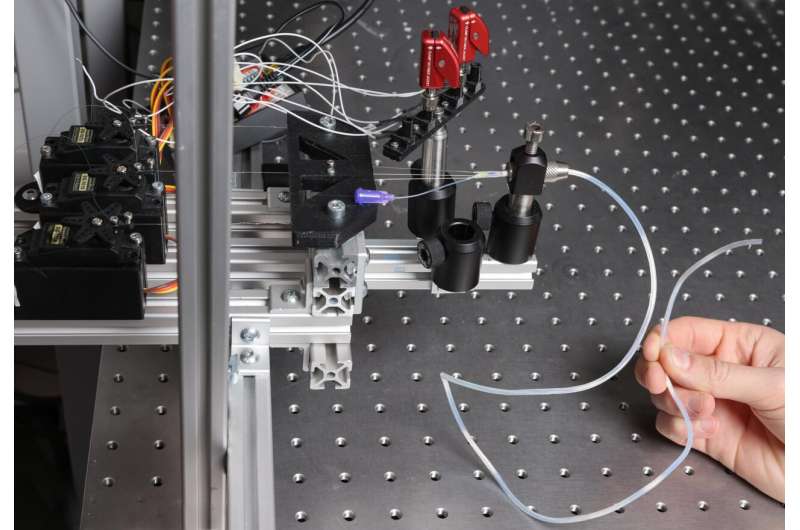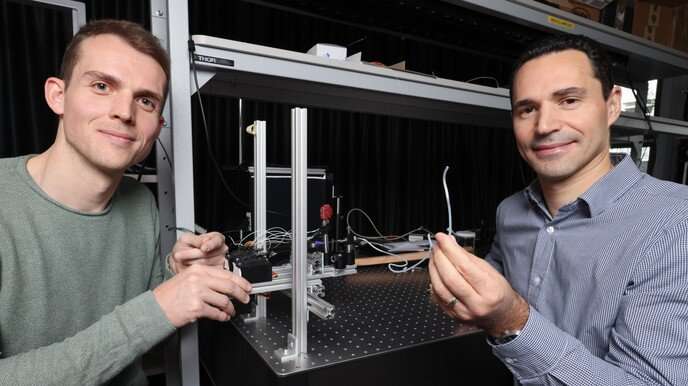Steerable soft robots could enhance medical applications

Borrowing from methods used to produce optical fibers, researchers from EPFL and Imperial College have created fiber-based soft robots with advanced motion control that integrate other functionalities, such as electric and optical sensing and targeted delivery of fluids.
In recent decades, catheter-based surgery has transformed medicine, giving doctors a minimally invasive way to do anything from placing stents and targeting tumors to extracting tissue samples and delivering contrast agents for medical imaging. While today's catheters are highly engineered robotic devices, in most cases, the task of pushing them through the body to the site of intervention continues to be a manual and time-consuming procedure.
Combining advances in the development of functional fibers with developments in smart robotics, researchers from the Laboratory of Photonic Materials and Fiber Devices in EPFL's School of Engineering have created multifunctional catheter-shaped soft robots that, when used as catheters, could be remotely guided to their destination or possibly even find their own way through semi-autonomous control. "This is the first time that we can generate soft catheter-like structures at such scalability that can integrate complex functionalities and be steered, potentially, inside the body," says Fabien Sorin, the study's principal investigator. Their work was published in the journal Advanced Science.
The researchers created the fibers with the thermal drawing process commonly used to produce fiber optic cables, similar to pulling a long string of cheese from a fondue and letting it harden. Material choice was critical, with elastomers—elastic polymers that return to their original shape when stretched—the preferred candidate: In addition to being flexible, they are soft enough to minimize lesions of delicate body tissues. But, says Andreas Leber, the first author of the study, "Historically, thermal drawing has been restricted to hard materials. Fortunately, our group had identified a class of thermoplastic elastomers that can be drawn and maintain their elastomeric properties after drawing."
Integrating motion control, sensing, and drug delivery
To generate long fibers featuring multiple channels along their entire length, the researchers had to fine-tune the drawing process parameters. "An important characteristic of the process is the interplay between the viscosity of the material, which lets you draw a continuous fiber, and the surface tension, which can cause the channels within them to collapse," says Fabien Sorin.
By getting the material properties, the drawing speed, and the temperature just right, the team could reliably produce the continuous channels, carefully arranged within the fibers at a micrometer scale, needed to give the fiber its robotic capabilities. For example, by using a motor to pull on one or several tendons introduced into channels—a well-established approach in smart catheters—doctors could control the orientation of the end of the fiber to guide it through the body.

Besides channels, the fibers can be equipped with a variety of elements using the thermal drawing process. "In addition to the tendons, the fibers can integrate optical guides, electrodes, and microchannels that enable drug delivery, imaging, electrical recording and stimulation, and other tools commonly used in robotics and medical applications," explains Leber.
These functional elements also open the door to autonomous fiber-shaped robots. "The integrated optical guides give fibers the sense of sight. They can detect and avoid obstacles in their trajectory and even find targeted objects, such as cavities, all on their own," continues Leber. Critical to this effort is a sophisticated control algorithm and software user interface developed from the ground up by the team in the lab.
Highly scalable fabrication
While it may sound complex, these multi-material fibers are remarkably simple to produce. "We use optical fiber fabrication technology, which is very scalable. You can generate hundreds of kilometers of optical fiber overnight. As a result, our fabrication approach brings a novel, scalable way to make soft catheter-like structures with an unprecedented combination of advanced functionalities," says Sorin.
Remotely controlled catheters are only one of many exciting potential applications that this new class of fiber-based soft robots could enable. "The tendon-based approach to motion control is a first step of the development of thermally drawn smart catheters. The next step will involve moving toward electrical or magnetic actuation modes and testing the exciting opportunities of such fibers one step closer to clinical applications," says Burak Temelkuran, co-author and group leader at the Hamlyn Center for Robotic Surgery at Imperial College.
Smart mattresses, soft prosthetics, and industrial robots
Soft robotic fibers also have a wealth of applications outside the human body. Mattresses could be equipped with them to monitor sleep quality or change their material properties in response to sensed pressure and physiological parameters, giving users a better night's sleep.
The fibers could be used to create soft prosthetics capable of responding to excess mechanical stress on a joint by becoming stiffer. And industrial or environmental sensing applications could include self-guiding soft robots that navigate based on information sensed by integrated heat sensors, haptic sensors, and even electrical and optical systems for vision.
More information: Andreas Leber et al, Highly Integrated Multi‐Material Fibers for Soft Robotics, Advanced Science (2022). DOI: 10.1002/advs.202204016


















